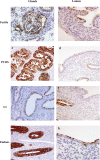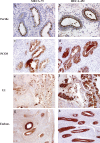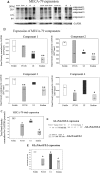L-selectin ligands in human endometrium: comparison of fertile and infertile subjects
- PMID: 19625313
- PMCID: PMC2763128
- DOI: 10.1093/humrep/dep247
L-selectin ligands in human endometrium: comparison of fertile and infertile subjects
Abstract
Background: L-selectin ligands, localized to the luminal epithelium at the time of implantation, may support the early stages of blastocyst attachment. We have assessed the expression of two L-selectin ligands, defined by MECA-79 and HECA-452 monoclonal antibodies, and the sulfotransferase GlcNAc6ST-2, involved in generation of L-selectin ligand epitopes, in the secretory phase of the endometrium from fertile and infertile patients.
Methods: Endometrial samples were obtained from 33 fertile, 26 PCOS, 25 endometriosis and 33 patients diagnosed with unexplained infertility. L-selectin ligands and GlcNAc6ST-2 expression was assessed by immunohistochemistry and immunoblotting.
Results: Immunohistochemical staining of uterine epithelium, from fertile and infertile women, demonstrated differential expression of MECA-79 and HECA-452 epitopes. In fertile women in the secretory phase MECA-79 was more strongly expressed, particularly on the lumen, than in infertile women. HECA-452 staining was significantly stronger in the glands in PCOS and endometriosis patients than in fertile women. GlcNAc6ST-2 expression was reduced in infertile patients, correlating with MECA-79 expression.
Conclusions: This study demonstrated significant differences in expression of L-selectin ligands between fertile and infertile women in natural cycles, and could contribute to patient assessment prior to initiating fertility treatment.
Figures





References
-
- Alon R, Feigelson S. From rolling to arrest on blood vessels: leukocyte tap dancing on endothelial integrin ligands and chemokines at sub-second contacts. Semin Immunol. 2002;14:93–104. - PubMed
-
- Ben-Nun I, Jaffe R, Fejgin MD, Beyth Y. Therapeutic maturation of endometrium in in vitro fertilization and embryo transfer. Fertil Steril. 1992;57:953–962. - PubMed
-
- Bistrup A, Tsay D, Shenoy P, Singer MS, Bangia N, Luther SA, Cyster JG, Ruddle NH, Rosen SD. Detection of a sulfotransferase (HEC-GlcNAc6ST) in high endothelial venules of lymph nodes and in high endothelial venule-like vessels within ectopic lymphoid aggregates: relationship to the MECA-79 Epitope. Am J Pathol. 2004;164:1635–1644. - PMC - PubMed
-
- Bos J, de Boer O, Tibosch E, Das P, Pals S. Skin-homing T lymphocytes: detection of cutaneous lymphocyte-associated antigen (CLA) by HECA-452 in normal human skin. Arch Dermatol Res. 1993;285:179–183. - PubMed
-
- Carson DD, Bagchi I, Dey SK, Enders AC, Fazleabas AT, Lessey BA, Yoshinaga K. Embryo implantation. Dev Biol. 2000;223:217–237. - PubMed
Publication types
MeSH terms
Substances
LinkOut - more resources
Full Text Sources
Medical

